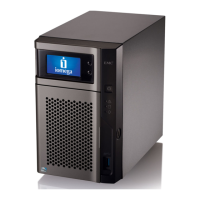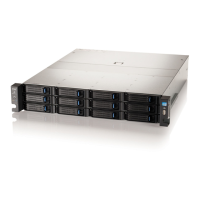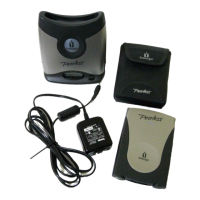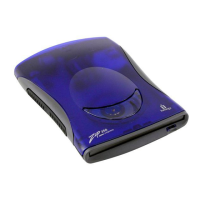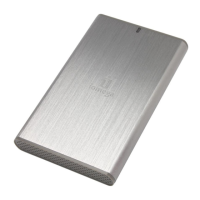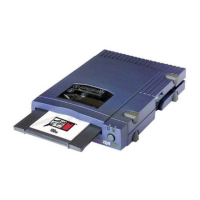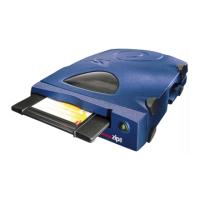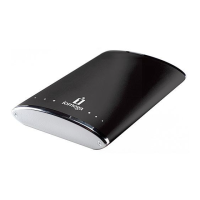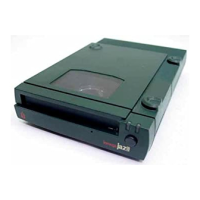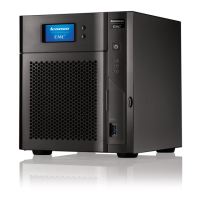
Do you have a question about the Iomega px4-400d and is the answer not in the manual?
| Model | px4-400d |
|---|---|
| Type | NAS |
| Drive Bays | 4 |
| Network Interface | 2 x Gigabit Ethernet |
| USB Ports | 3 x USB 3.0 |
| Operating System Compatibility | Windows, Mac OS, Linux |
| Weight | 2.5 kg |
| Supported Drive Types | 3.5" SATA II/III HDD/SSD |
| Supported RAID Levels | RAID 0, 1, 5, 10, JBOD |
| Maximum Raw Capacity | 16 TB |
| Protocols | CIFS, NFS, FTP, HTTP, HTTPS |
| Storage Capacity | Up to 16 TB |
General introduction to the setup process for the px4-400d Network Storage.
Details about the physical parts, controls, and indicators of the px4-400d device.
Instructions on how to connect the px4-400d device to your network.
Important safety guidelines for using the px4-400d Network Storage.
Troubleshooting steps if the px4-400d device is not automatically discovered.
The initial device configuration process and options available.
How to view and change network configuration settings on the px4-400d.
Detailed steps for manually setting IP addresses, DNS, and WINS servers.
How to combine multiple network interface cards for redundancy or bandwidth.
How to configure Virtual Local Area Networks for each network interface.
How to set the device name, descriptive name, and workgroup name.
How to integrate the px4-400d with an Active Directory domain.
How to customize feature display and access for non-administrator users.
How to configure the device to send email alerts for detected problems.
How to view and download event logs to monitor device activity.
How to monitor overall system health and space usage information.
Overview of the automatic security measures during device setup.
How to configure encryption options and security settings.
Introduction to managing users and groups on the px4-400d.
Step-by-step guide to creating new user accounts.
How to change user information, access permissions, and quotas.
How to create new groups and add users to them.
How to manage existing groups, including permissions and user removal.
Overview of integrating with Active Directory for user management.
How to import, synchronize, and manage AD users and groups.
How to use both local and Active Directory users simultaneously.
How to set access permissions for AD and local users on shares.
Introduction to file sharing capabilities and interfaces.
What shares are and how to organize content within them.
How to manage user access rights to shares.
How to change share information, permissions, and enable NFS access.
Overview of communication protocols for file sharing.
How to present content to users via the device's home page.
How to share content on social media sites via active folders.
How to configure Facebook active folders for automatic photo uploads.
How to configure Flickr active folders for automatic image uploads.
How to configure YouTube active folders for automatic video uploads.
How to manage storage settings and apply global settings to drives.
Information about existing storage pools, including name, protection, and capacity.
How to view the status and physical layout of the device drives.
Instructions for installing new hard drives or SSDs.
How content is stored using shares, volumes, and storage pools.
What a storage pool is and its basic requirements.
How to create, manage, and delete storage pools.
How to use SSDs to create a cache pool for better performance.
Introduction to iSCSI and its use for high-speed data transmission.
Steps to add new iSCSI drives to the px4-400d.
How to manage iSCSI drives, including CHAP user access.
How to delete iSCSI drives from the px4-400d.
Overview of various methods to back up and restore content.
How to set up Time Machine backups to the px4-400d.
Introduction to the Copy Jobs feature for transferring files.
Details on creating and managing copy jobs for backups.
How to restore files using the Copy Jobs feature.
How to back up files to the Amazon S3 cloud service.
Introduction to the Personal Cloud feature for remote access and sharing.
Information on the security of content within the Personal Cloud.
Steps to create and configure a Personal Cloud.
How to configure router port forwarding for Personal Cloud access.
How to manage trusted devices connected to the Personal Cloud.
How users access content through the Personal Cloud.
Overview of sharing content on social media sites.
How to configure Facebook active folders for automatic uploads.
How to configure Flickr active folders for automatic uploads.
How to configure YouTube active folders for automatic uploads.
Introduction to the built-in Media Server feature.
How the Media Server scans for and makes media content available.
What the Media Server feature can do and its limitations.
How to enable internet access for sharing media content.
How to combine media content from multiple DLNA servers.
How to stream media files to network media players.
Managing photos, including streaming, slideshows, and resizing.
Managing music files, including streaming and scanning.
Managing video files, including streaming and scanning.
Overview of the Application Manager page for installing applications.
Steps required to install applications on the px4-400d.
How to add, start, stop, and remove applications.
How to update the px4-400d software via auto or manual processes.
Overview of backing up and restoring system configuration information.
How to back up the device's configuration settings to a file.
How to restore the device configuration from a saved backup file.
How to manage power settings like drive power down and schedules.
How to reset the px4-400d to its original state.
How to monitor the status of an attached Uninterruptible Power Supply.
How to resolve common router connectivity issues.
Information on how to get customer support and access online resources.
Information about the LenovoEMC support website.
Details about the product warranty period and types of service.
Important regulatory compliance information for various regions.
